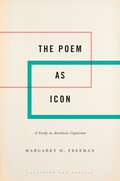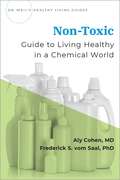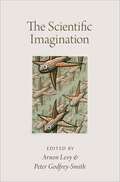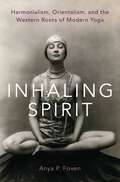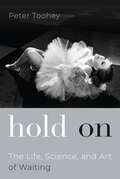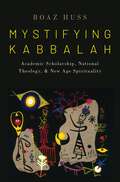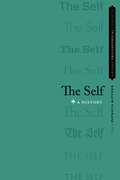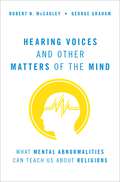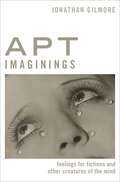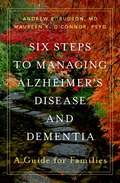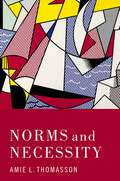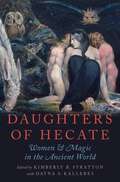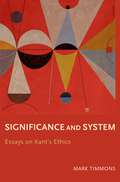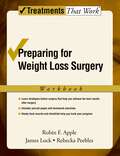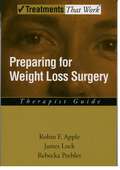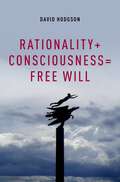- Table View
- List View
The Poem as Icon: A Study in Aesthetic Cognition (Cognition and Poetics)
by Margaret H. FreemanPoetry is the most complex and intricate of human language used across all languages and cultures. Its relation to the worlds of human experience has perplexed writers and readers for centuries, as has the question of evaluation and judgment: what makes a poem "work" and endure. The Poem as Icon focuses on the art of poetry to explore its nature and function: not interpretation but experience; not what poetry means but what it does. Using both historic and contemporary approaches of embodied cognition from various disciplines, Margaret Freeman argues that a poem's success lies in its ability to become an icon of the felt "being" of reality. Freeman explains how the features of semblance, metaphor, schema, and affect work to make a poem an icon, with detailed examples from various poets. By analyzing the ways poetry provides insights into the workings of human cognition, Freeman claims that taste, beauty, and pleasure in the arts are simply products of the aesthetic faculty, and not the aesthetic faculty itself. The aesthetic faculty, she argues, should be understood as the science of human perception, and therefore constitutive of the cognitive processes of attention, imagination, memory, discrimination, expertise, and judgment.
Non-Toxic: Guide to Living Healthy in a Chemical World (Dr Weil's Healthy Living Guides)
by Aly Cohen Frederick vom SaalThere is no question that our environment has changed dramatically over the past few decades. The influx of thousands of toxic chemicals that seep into every aspect of our lives wreaking havoc on our bodies can seem daunting, but research now shows that by making simple changes, we can dramatically reduce exposures to many harmful chemicals that we eat, breathe, and lather on our skin. Non-Toxic is a practical guide to living healthier in our modern environment. It teaches how to reduce chemical and radiation exposures by recognizing potential threats and paying attention to what you eat, breathe, and put onto your skin. Written in clear, easy-to-understand language and based on scientific evidence, this book is filled with resources, tools, tear-off sheets, recipes, and practical, cost-effective tips designed to help you: · Understand and decode product and food labels · Create delicious recipes to help detoxify your body · Choose and prepare food and drinks safely and healthfully · Furnish and clean your home for a healthy indoor environment · Safely disinfect surfaces from COVID-19 · Create do-it-yourself cleaning product recipes · Choose safer personal care products and cosmetics · Reduce exposure to pesticides in and around your home · Ensure safe drinking water for you, your family and pets · Reduce exposure to EMF radiation from cell phones, laptops and other tech toys · Make informed decisions about toys, baby products, and other environmental issues affecting your children Written by a board-certified Rheumatologist and Integrative Medicine Physician, and a renowned PhD professor of neuro- and reproductive biology, Non-Toxic is designed to be referred to again and again for its relevant, cost-effective, and practical ways to reduce exposure and thereby lower risk for developing a variety of environmentally associated illnesses. ABOUT THE SERIES: From series editor, Andrew Weil, one of the most iconic and trusted names in healthcare today, the Dr. Weil's Healthy Living Guides series discusses caring for common medical conditions and optimizing health from an integrative medical approach. Integrative medicine is defined as an evidence-based healing-oriented medicine that takes account of the whole person (body, mind, and spirit), including all aspects of lifestyle. It emphasizes the therapeutic relationship and makes use of all appropriate therapies, conventional, alternative, and complementary.
Non-Toxic: Guide to Living Healthy in a Chemical World (Dr Weil's Healthy Living Guides)
by Aly Cohen Frederick vom SaalThere is no question that our environment has changed dramatically over the past few decades. The influx of thousands of toxic chemicals that seep into every aspect of our lives wreaking havoc on our bodies can seem daunting, but research now shows that by making simple changes, we can dramatically reduce exposures to many harmful chemicals that we eat, breathe, and lather on our skin. Non-Toxic is a practical guide to living healthier in our modern environment. It teaches how to reduce chemical and radiation exposures by recognizing potential threats and paying attention to what you eat, breathe, and put onto your skin. Written in clear, easy-to-understand language and based on scientific evidence, this book is filled with resources, tools, tear-off sheets, recipes, and practical, cost-effective tips designed to help you: · Understand and decode product and food labels · Create delicious recipes to help detoxify your body · Choose and prepare food and drinks safely and healthfully · Furnish and clean your home for a healthy indoor environment · Safely disinfect surfaces from COVID-19 · Create do-it-yourself cleaning product recipes · Choose safer personal care products and cosmetics · Reduce exposure to pesticides in and around your home · Ensure safe drinking water for you, your family and pets · Reduce exposure to EMF radiation from cell phones, laptops and other tech toys · Make informed decisions about toys, baby products, and other environmental issues affecting your children Written by a board-certified Rheumatologist and Integrative Medicine Physician, and a renowned PhD professor of neuro- and reproductive biology, Non-Toxic is designed to be referred to again and again for its relevant, cost-effective, and practical ways to reduce exposure and thereby lower risk for developing a variety of environmentally associated illnesses. ABOUT THE SERIES: From series editor, Andrew Weil, one of the most iconic and trusted names in healthcare today, the Dr. Weil's Healthy Living Guides series discusses caring for common medical conditions and optimizing health from an integrative medical approach. Integrative medicine is defined as an evidence-based healing-oriented medicine that takes account of the whole person (body, mind, and spirit), including all aspects of lifestyle. It emphasizes the therapeutic relationship and makes use of all appropriate therapies, conventional, alternative, and complementary.
The Scientific Imagination
by Arnon Levy, Peter Godfrey-SmithThe imagination, our capacity to entertain thoughts and ideas "in the mind's eye," is indispensable in science as elsewhere in human life. Indeed, common scientific practices such as modeling and idealization rely on the imagination to construct simplified, stylized scenarios essential for scientific understanding. Yet the philosophy of science has traditionally shied away from according an important role to the imagination, wary of psychologizing fundamental scientific concepts like explanation and justification. In recent years, however, advances in thinking about creativity and fiction, and their relation to theorizing and understanding, have prompted a move away from older philosophical perspectives and toward a greater acknowledgement of the place of the imagination in scientific practice. Meanwhile, psychologists have engaged in significant experimental work on the role of the imagination in causal thinking and probabilistic reasoning. The Scientific Imagination delves into this burgeoning area of debate at the intersection of the philosophy and practice of science, bringing together the work of leading researchers in philosophy and psychology. Philosophers discuss such topics as modeling, idealization, metaphor and explanation, examining their role within science as well as how they affect questions in metaphysics, epistemology and philosophy of language. Psychologists discuss how our imaginative capacities develop and how they work, their relationships with processes of reasoning, and how they compare to related capacities, such as categorization and counterfactual thinking. Together, these contributions combine to provide a comprehensive and exciting picture of the scientific imagination.
Inhaling Spirit: Harmonialism, Orientalism, and the Western Roots of Modern Yoga
by Anya P. FoxenRecent scholarship has shown that modern postural yoga is the outcome of a complex process of transcultural exchange and syncretism. This book doubles down on those claims and digs even deeper, looking to uncover the disparate but entangled roots of modern yoga practice. Anya Foxen shows that some of what we call yoga, especially in North America and Europe, is genealogically only slightly related to pre-modern Indian yoga traditions. Rather, it is equally, if not more so, grounded in Hellenistic theories of the subtle body, Western esotericism and magic, pre-modern European medicine, and late-nineteenth-century women's wellness programs. The book begins by examining concepts arising out of Greek philosophy and religion, including Pythagoreanism, Stoicism, Neo-Platonism, Galenic medicine, theurgy, and other cultural currents that have traditionally been categorized as "Western esotericism," as well as the more recent examples which scholars of American traditions have labeled "metaphysical religion." Marshaling these under the umbrella category of "harmonialism," Foxen argues that they represent a history of practices that were gradually subsumed into the language of yoga. Orientalism and gender become important categories of analysis as this narrative moves into the nineteenth century. Women considerably outnumber men in all studies of yoga except those conducted in India, and modern anglophone yoga exhibits important continuities with women's physical culture, feminist reform, and white women's engagement with Orientalism. Foxen's study allows us to recontextualize the peculiarities of American yoga--its focus on aesthetic representation, its privileging of bodily posture and unsystematic incorporation of breathwork, and above all its overwhelmingly white female demographic. In this context it addresses the ongoing conversation about cultural appropriation within the yoga community.
Inhaling Spirit: Harmonialism, Orientalism, and the Western Roots of Modern Yoga
by Anya P. FoxenRecent scholarship has shown that modern postural yoga is the outcome of a complex process of transcultural exchange and syncretism. This book doubles down on those claims and digs even deeper, looking to uncover the disparate but entangled roots of modern yoga practice. Anya Foxen shows that some of what we call yoga, especially in North America and Europe, is genealogically only slightly related to pre-modern Indian yoga traditions. Rather, it is equally, if not more so, grounded in Hellenistic theories of the subtle body, Western esotericism and magic, pre-modern European medicine, and late-nineteenth-century women's wellness programs. The book begins by examining concepts arising out of Greek philosophy and religion, including Pythagoreanism, Stoicism, Neo-Platonism, Galenic medicine, theurgy, and other cultural currents that have traditionally been categorized as "Western esotericism," as well as the more recent examples which scholars of American traditions have labeled "metaphysical religion." Marshaling these under the umbrella category of "harmonialism," Foxen argues that they represent a history of practices that were gradually subsumed into the language of yoga. Orientalism and gender become important categories of analysis as this narrative moves into the nineteenth century. Women considerably outnumber men in all studies of yoga except those conducted in India, and modern anglophone yoga exhibits important continuities with women's physical culture, feminist reform, and white women's engagement with Orientalism. Foxen's study allows us to recontextualize the peculiarities of American yoga--its focus on aesthetic representation, its privileging of bodily posture and unsystematic incorporation of breathwork, and above all its overwhelmingly white female demographic. In this context it addresses the ongoing conversation about cultural appropriation within the yoga community.
Hold On: The Life, Science, and Art of Waiting
by Peter TooheyWhat do you do when you're not asleep and when you're not eating? You're most likely waiting--to finish work, to get home, or maybe even to be seen by your doctor. Hold On is less about how to manage all that "staying where one is until a particular time or event" (OED) than it is about describing how we experience waiting. Waiting can embrace things like hesitation and curiosity, dithering and procrastination, hunting and being hunted, fearing and being feared, dread and illness, courting and parenting, anticipation and excitement, curiosity, listening to and even performing music, being religious, being happy or unhappy, being bored and being boring. They're all explored here. Waiting is also characterized by brain chemicals such as serotonin and dopamine. They can radically alter the way we register the passing of time. Waiting is also the experience that may characterize most interpersonal relations--mismanage it at your own risk. Hold On contains advice on how to cope with waiting-how to live better-but its main aim is to show how important the experience of waiting is, in popular and highbrow culture, and, sometimes, in history. Detouring into psychology, neurology, ethology, philosophy, film, literature, and especially art, Peter Toohey's illuminates in unexpected ways one of the most common of human experiences. After reading his book, you'll never wait the same way again.
Hold On: The Life, Science, and Art of Waiting
by Peter TooheyWhat do you do when you're not asleep and when you're not eating? You're most likely waiting--to finish work, to get home, or maybe even to be seen by your doctor. Hold On is less about how to manage all that "staying where one is until a particular time or event" (OED) than it is about describing how we experience waiting. Waiting can embrace things like hesitation and curiosity, dithering and procrastination, hunting and being hunted, fearing and being feared, dread and illness, courting and parenting, anticipation and excitement, curiosity, listening to and even performing music, being religious, being happy or unhappy, being bored and being boring. They're all explored here. Waiting is also characterized by brain chemicals such as serotonin and dopamine. They can radically alter the way we register the passing of time. Waiting is also the experience that may characterize most interpersonal relations--mismanage it at your own risk. Hold On contains advice on how to cope with waiting-how to live better-but its main aim is to show how important the experience of waiting is, in popular and highbrow culture, and, sometimes, in history. Detouring into psychology, neurology, ethology, philosophy, film, literature, and especially art, Peter Toohey's illuminates in unexpected ways one of the most common of human experiences. After reading his book, you'll never wait the same way again.
Mystifying Kabbalah: Academic Scholarship, National Theology, and New Age Spirituality (Oxford Studies in Western Esotericism)
by Boaz HussMost scholars of Judaism take the term "Jewish mysticism" for granted, and do not engage in a critical discussion of the essentialist perceptions that underlie it. Mystifying Kabbalah studies the evolution of the concept of Jewish mysticism. It examines the major developments in the academic study of Jewish mysticism and its impact on modern Kabbalistic movements in the contexts of Jewish nationalism and New Age spirituality. Boaz Huss argues that Jewish mysticism is a modern discursive construct and that the identification of Kabbalah and Hasidism as forms of mysticism, which appeared for the first time in the nineteenth century and has become prevalent since the early twentieth, shaped the way in which Kabbalah and Hasidism are perceived and studied today. The notion of Jewish mysticism was established when western scholars accepted the modern idea that mysticism is a universal religious phenomenon of a direct experience of a divine or transcendent reality and applied it to Kabbalah and Hasidism. "Jewish mysticism" gradually became the defining category in the modern academic research of these topics. This book clarifies the historical, cultural, and political contexts that led to the identification of Kabbalah and Hasidism as Jewish mysticism, exposing the underlying ideological and theological presuppositions and revealing the impact of this "mystification" on contemporary forms of Kabbalah and Hasidism.
Mystifying Kabbalah: Academic Scholarship, National Theology, and New Age Spirituality (Oxford Studies in Western Esotericism)
by Boaz HussMost scholars of Judaism take the term "Jewish mysticism" for granted, and do not engage in a critical discussion of the essentialist perceptions that underlie it. Mystifying Kabbalah studies the evolution of the concept of Jewish mysticism. It examines the major developments in the academic study of Jewish mysticism and its impact on modern Kabbalistic movements in the contexts of Jewish nationalism and New Age spirituality. Boaz Huss argues that Jewish mysticism is a modern discursive construct and that the identification of Kabbalah and Hasidism as forms of mysticism, which appeared for the first time in the nineteenth century and has become prevalent since the early twentieth, shaped the way in which Kabbalah and Hasidism are perceived and studied today. The notion of Jewish mysticism was established when western scholars accepted the modern idea that mysticism is a universal religious phenomenon of a direct experience of a divine or transcendent reality and applied it to Kabbalah and Hasidism. "Jewish mysticism" gradually became the defining category in the modern academic research of these topics. This book clarifies the historical, cultural, and political contexts that led to the identification of Kabbalah and Hasidism as Jewish mysticism, exposing the underlying ideological and theological presuppositions and revealing the impact of this "mystification" on contemporary forms of Kabbalah and Hasidism.
The Self: A History (Oxford Philosophical Concepts)
by Patricia KitcherThe Self: A History explores the ways in which the concept of an 'I' or a 'self' has been developed and deployed at different times in the history of Western Philosophy. It also offers a striking contrast case, the 'interconnected' self, who appears in some expressions of African Philosophy. The I or self seems engulfed in paradoxes. We are selves and we seem to be conscious of ourselves, yet it is very difficult to say what a self is. Although we refer to ourselves, when we try to find or locate ourselves, the I seems elusive. We can find human bodies, but we do not refer to ourselves by referring to our bodies: we do not know that we are raising our hands or thinking hard by looking at our arms or catching a glimpse of our furrowed brows in a mirror. The essays in this volume engage many philosophical resources--metaphysics, epistemology, phenomenology, philosophy of psychology and philosophy of language--to try to shed needed light on these puzzles.
The Self: A History (Oxford Philosophical Concepts)
by Patricia KitcherThe Self: A History explores the ways in which the concept of an 'I' or a 'self' has been developed and deployed at different times in the history of Western Philosophy. It also offers a striking contrast case, the 'interconnected' self, who appears in some expressions of African Philosophy. The I or self seems engulfed in paradoxes. We are selves and we seem to be conscious of ourselves, yet it is very difficult to say what a self is. Although we refer to ourselves, when we try to find or locate ourselves, the I seems elusive. We can find human bodies, but we do not refer to ourselves by referring to our bodies: we do not know that we are raising our hands or thinking hard by looking at our arms or catching a glimpse of our furrowed brows in a mirror. The essays in this volume engage many philosophical resources--metaphysics, epistemology, phenomenology, philosophy of psychology and philosophy of language--to try to shed needed light on these puzzles.
Hearing Voices and Other Matters of the Mind: What Mental Abnormalities Can Teach Us About Religions
by Robert N. McCauley George GrahamA man with schizophrenia believes that God is instructing him through the public address system in a bus station. A nun falls into a decades-long depression because she believes that God refuses to answer her prayers. A neighborhood parishioner is bedeviled with anxiety because he believes that a certain religious ritual must be repeated, repeated, and repeated lest God punish him. To what extent are such manifestations of religious thinking analogous to mental disorder? Does mental dysfunction bring an individual closer to religious experience or thought? Hearing Voices and Other Unusual Experiences explores these questions using the tools of the cognitive science of religion and the philosophy of psychopathology. Robert McCauley and George Graham emphasize underlying cognitive continuities between familiar features of religiosity, of mental disorders, and of everyday thinking and action. They contend that much religious thought and behavior can be explained as the cultural activation of our natural cognitive systems, which address matters that are essential to human survival: hazard precautions, agency detection, language processing, and theory of mind. Those systems produce responses to cultural stimuli that may mimic features of cognition and conduct associated with mental disorders, but which are sometimes coded as "religious" depending on the context. The authors examine hallucinations of the voice of God and of other supernatural agents, spiritual depression often described as a "dark night of the soul," religious scrupulosity and compulsiveness, and challenges to theistic cognition that Autistic Spectrum Disorder poses. Their approach promises to shed light on both mental abnormalities and religiosity.
Hearing Voices and Other Matters of the Mind: What Mental Abnormalities Can Teach Us About Religions
by George Graham Robert N. McCauleyA man with schizophrenia believes that God is instructing him through the public address system in a bus station. A nun falls into a decades-long depression because she believes that God refuses to answer her prayers. A neighborhood parishioner is bedeviled with anxiety because he believes that a certain religious ritual must be repeated, repeated, and repeated lest God punish him. To what extent are such manifestations of religious thinking analogous to mental disorder? Does mental dysfunction bring an individual closer to religious experience or thought? Hearing Voices and Other Unusual Experiences explores these questions using the tools of the cognitive science of religion and the philosophy of psychopathology. Robert McCauley and George Graham emphasize underlying cognitive continuities between familiar features of religiosity, of mental disorders, and of everyday thinking and action. They contend that much religious thought and behavior can be explained as the cultural activation of our natural cognitive systems, which address matters that are essential to human survival: hazard precautions, agency detection, language processing, and theory of mind. Those systems produce responses to cultural stimuli that may mimic features of cognition and conduct associated with mental disorders, but which are sometimes coded as "religious" depending on the context. The authors examine hallucinations of the voice of God and of other supernatural agents, spiritual depression often described as a "dark night of the soul," religious scrupulosity and compulsiveness, and challenges to theistic cognition that Autistic Spectrum Disorder poses. Their approach promises to shed light on both mental abnormalities and religiosity.
Apt Imaginings: Feelings for Fictions and Other Creatures of the Mind (Thinking Art)
by Jonathan GilmoreHow do our engagements with fictions and other products of the imagination compare to our experiences of the real world? Are the feelings we have about a novel's characters modelled on our thoughts about actual people? If it is wrong to feel pleasure over certain situations in real life, can it nonetheless be right to take pleasure in analogous scenarios represented in a fantasy or film? Should the desires we have for what goes on in a make-believe story cohere with what we want to happen in the actual world? Such queries have animated philosophical and psychological theorizing about art and life from Plato's Republic and Aristotle's Poetics to contemporary debates over freedom of expression, ethics and aesthetics, the cognitive value of thought experiments, and the effects on audiences of exposure to violent entertainment. In Apt Imaginings, Jonathan Gilmore develops a new framework to pursue these questions, marshalling a wide range of research in aesthetics, the science of the emotions, moral philosophy, neuroscience, cognitive psychology, and film and literary theory. Gilmore argues that, while there is a substantial empirical continuity in our feelings across art and life, the norms that govern the appropriateness of those responses across the divide are discontinuous. In this view, the evaluative criteria that determine the fit, correctness, or rationality of our emotions and desires for what is internal to a fiction can be contrary to those that govern our affective attitudes toward analogous things in the real world. In short, it can be right to embrace within a story what one would condemn in real life. The theory Gilmore defends in this volume helps to explain our complex and sometimes conflicted attitudes toward works of the imagination; challenges the popular view that fictions serve to refine our moral sensibilities; and exposes a kind of autonomy of the imagination that can render our responses to art immune to standard real-world epistemic, practical, and affective kinds of criticism.
Apt Imaginings: Feelings for Fictions and Other Creatures of the Mind (Thinking Art)
by Jonathan GilmoreHow do our engagements with fictions and other products of the imagination compare to our experiences of the real world? Are the feelings we have about a novel's characters modelled on our thoughts about actual people? If it is wrong to feel pleasure over certain situations in real life, can it nonetheless be right to take pleasure in analogous scenarios represented in a fantasy or film? Should the desires we have for what goes on in a make-believe story cohere with what we want to happen in the actual world? Such queries have animated philosophical and psychological theorizing about art and life from Plato's Republic and Aristotle's Poetics to contemporary debates over freedom of expression, ethics and aesthetics, the cognitive value of thought experiments, and the effects on audiences of exposure to violent entertainment. In Apt Imaginings, Jonathan Gilmore develops a new framework to pursue these questions, marshalling a wide range of research in aesthetics, the science of the emotions, moral philosophy, neuroscience, cognitive psychology, and film and literary theory. Gilmore argues that, while there is a substantial empirical continuity in our feelings across art and life, the norms that govern the appropriateness of those responses across the divide are discontinuous. In this view, the evaluative criteria that determine the fit, correctness, or rationality of our emotions and desires for what is internal to a fiction can be contrary to those that govern our affective attitudes toward analogous things in the real world. In short, it can be right to embrace within a story what one would condemn in real life. The theory Gilmore defends in this volume helps to explain our complex and sometimes conflicted attitudes toward works of the imagination; challenges the popular view that fictions serve to refine our moral sensibilities; and exposes a kind of autonomy of the imagination that can render our responses to art immune to standard real-world epistemic, practical, and affective kinds of criticism.
Six Steps to Managing Alzheimer's Disease and Dementia: A Guide for Families
by Andrew E. Budson Maureen K. O'ConnorYour needs as a caregiver are just as important as those your family member with Alzheimer's Disease or dementia. This book will provide just the insight and guidance you need. Caregiving for a loved one with Alzheimer's disease or dementia is hard. It's hard whether you're caring for your spouse, parent, grandparent, sibling, other family member, or friend. Even if you had an extra ten hours each day to do it, it's hard to manage all the problems that come with dementia. And caring for a loved one with dementia can sometimes feel like a long, lonely journey. Six Steps to Managing Alzheimer's Disease and Dementia can help, addressing concerns such as: · Is the problem Alzheimer's, dementia, or something else? · How do you approach problems in dementia? · How do you manage problems with memory, language, and vision? · How do you cope with emotional and behavioral problems? · What are the best ways to manage troubles with sleep and incontinence? · Which medications can help? · Which medications can actually make things worse? · How do you build your care team? · Why is it important to care for yourself? · How do you sustain your relationship with your loved one? · How do you plan for the progression of dementia? · How do you plan for the end and beyond? Six Steps to Managing Alzheimer's Disease and Dementia is comprehensive yet written in an easy-to-read style, featuring clinical vignettes and character-based stories that provide real-life examples of how to successfully manage Alzheimer's disease and dementia.
Six Steps to Managing Alzheimer's Disease and Dementia: A Guide for Families
by Andrew E. Budson Maureen K. O'ConnorYour needs as a caregiver are just as important as those your family member with Alzheimer's Disease or dementia. This book will provide just the insight and guidance you need. Caregiving for a loved one with Alzheimer's disease or dementia is hard. It's hard whether you're caring for your spouse, parent, grandparent, sibling, other family member, or friend. Even if you had an extra ten hours each day to do it, it's hard to manage all the problems that come with dementia. And caring for a loved one with dementia can sometimes feel like a long, lonely journey. Six Steps to Managing Alzheimer's Disease and Dementia can help, addressing concerns such as: · Is the problem Alzheimer's, dementia, or something else? · How do you approach problems in dementia? · How do you manage problems with memory, language, and vision? · How do you cope with emotional and behavioral problems? · What are the best ways to manage troubles with sleep and incontinence? · Which medications can help? · Which medications can actually make things worse? · How do you build your care team? · Why is it important to care for yourself? · How do you sustain your relationship with your loved one? · How do you plan for the progression of dementia? · How do you plan for the end and beyond? Six Steps to Managing Alzheimer's Disease and Dementia is comprehensive yet written in an easy-to-read style, featuring clinical vignettes and character-based stories that provide real-life examples of how to successfully manage Alzheimer's disease and dementia.
Norms and Necessity
by Amie L. ThomassonClaims about what is metaphysically necessary or possible have long played a central role in metaphysics and other areas of philosophy. Such claims are traditionally thought of as aiming to describe a special kind of modal fact or property, or perhaps facts about other possible worlds. But that assumption leads to difficult ontological, epistemological, and methodological puzzles. Should we accept that there are modal facts or properties, or other possible worlds? If so, what could these things be? How could we come to know what the modal facts or properties are? How can we resolve philosophical debates about what is metaphysically necessary or possible? Norms and Necessity develops a new approach to understanding our claims about metaphysical possibility and necessity: Modal Normativism. The Normativist rejects the assumption that modal claims aim to describe modal features or possible worlds, arguing instead that they serve as useful ways of conveying, reasoning with, and renegotiating semantic rules and their consequences. By dropping the descriptivist assumption, the Normativist is able to unravel the notorious ontological problems of modality, and provide a clear and plausible story about how we can come to know what is metaphysically necessary or possible. Most importantly, this approach helps demystify philosophical methodology. It reveals that resolving metaphysical modal questions does not require a special form of philosophical insight or intuition. Instead, it requires nothing more mysterious than empirical knowledge, conceptual mastery, and an ability to explicitly convey and renegotiate semantic rules.
Norms and Necessity
by Amie L. ThomassonClaims about what is metaphysically necessary or possible have long played a central role in metaphysics and other areas of philosophy. Such claims are traditionally thought of as aiming to describe a special kind of modal fact or property, or perhaps facts about other possible worlds. But that assumption leads to difficult ontological, epistemological, and methodological puzzles. Should we accept that there are modal facts or properties, or other possible worlds? If so, what could these things be? How could we come to know what the modal facts or properties are? How can we resolve philosophical debates about what is metaphysically necessary or possible? Norms and Necessity develops a new approach to understanding our claims about metaphysical possibility and necessity: Modal Normativism. The Normativist rejects the assumption that modal claims aim to describe modal features or possible worlds, arguing instead that they serve as useful ways of conveying, reasoning with, and renegotiating semantic rules and their consequences. By dropping the descriptivist assumption, the Normativist is able to unravel the notorious ontological problems of modality, and provide a clear and plausible story about how we can come to know what is metaphysically necessary or possible. Most importantly, this approach helps demystify philosophical methodology. It reveals that resolving metaphysical modal questions does not require a special form of philosophical insight or intuition. Instead, it requires nothing more mysterious than empirical knowledge, conceptual mastery, and an ability to explicitly convey and renegotiate semantic rules.
Daughters of Hecate: Women and Magic in the Ancient World
by Kimberly B. StrattonDaughters of Hecate unites for the first time research on the problem of gender and magic in three ancient Mediterranean societies: early Judaism, Christianity, and Graeco-Roman culture. The book illuminates the gendering of ancient magic by approaching the topic from three distinct disciplinary perspectives: literary stereotyping, the social application of magic discourse, and material culture. The authors probe the foundations of, processes, and motivations behind gendered stereotypes, beginning with Western culture's earliest associations of women and magic in the Bible and Homer's Odyssey. Daughters of Hecate provides a nuanced exploration of the topic while avoiding reductive approaches. In fact, the essays in this volume uncover complexities and counter-discourses that challenge, rather than reaffirm, many gendered stereotypes taken for granted and reified by most modern scholarship. By combining critical theoretical methods with research into literary and material evidence, Daughters of Hecate interrogates a false association that has persisted from antiquity, to early modern witch hunts, to the present day.
Significance and System: Essays on Kant's Ethics
by Mark TimmonsSignificance and System: Essays on Kant's Ethics brings together central lines of thought in Mark Timmons's work on Kant's moral theory. The first part of the book concerns the interpretation and justification of the categorical imperative in which Timmons argues for a "differential roles" interpretation of the categorical imperative, according to which distinct formulations of this principle play different roles in the overall economy of Kant's ethics. In addition he offers a detailed interpretation of the analytic/synthetic distinction in Kant's ethics that plays a central role in Kant's justification of his supreme moral principle. In the second part, Timmons addresses questions about the relation between motive and rightness, arguing, for example, that contemporary Kantians have misunderstood that relation. This part also examines Kant's attempt in the Doctrine of Virtue to ground a system of ethical duties in the categorical imperative. In part three, Timmons turns to issues in Kant's psychology of moral evil, including the psychology of the devilish vices. Throughout Timmons combines interpretive insight with a critical eye in interpreting and criticizing Kant's ethical thought.
Preparing for Weight Loss Surgery (Treatments That Work)
by James Lock Robin F. Apple Rebecka PeeblesWeight loss surgery is becoming more and more popular as a long-term solution for people to regain control of their bodies and their health. Once you make the decision to undergo surgery, it is up to you to ensure the best possible outcome. This will entail radical changes in both your lifestyle and eating habits. To reap the maximum benefits of your weight loss surgery, you must learn new methods for dealing with unhealthy attitudes about food. When used in conjunction with therapy, this workbook provides practical tools that have been scientifically tested and shown to help people successfully prepare for, and overcome the post-operative challenges of creating new and healthy eating and lifestyle habits. This treatment program does more than teach you how to guarantee yourself a successful recovery after surgery; it teaches you the skills to manage your health and weight for the rest of your life. This workbook includes user-friendly devices to help you learn these new skills, including food records and checklists, body image journals, weight graphs, problem-solving exercises, and interactive homework assignments. Written by professionals in the area of eating disorders and obesity, this book will help you take control of your health as you begin your new life after weight loss surgery. TreatmentsThatWorkTM represents the gold standard of behavioral healthcare interventions! · All programs have been rigorously tested in clinical trials and are backed by years of research · A prestigious scientific advisory board, led by series Editor-In-Chief David H. Barlow, reviews and evaluates each intervention to ensure that it meets the highest standard of evidence so you can be confident that you are using the most effective treatment available to date · Our books are reliable and effective and make it easy for you to provide your clients with the best care available · Our corresponding workbooks contain psychoeducational information, forms and worksheets, and homework assignments to keep clients engaged and motivated · A companion website (www.oup.com/us/ttw) offers downloadable clinical tools and helpful resources · Continuing Education (CE) Credits are now available on select titles in collaboration with PsychoEducational Resources, Inc. (PER)
Preparing for Weight Loss Surgery (Treatments That Work)
by James Lock Robin F. Apple Rebecka PeeblesObesity has quickly become an American epidemic. People suffering from significant overweight often have to contend with a lifetime of significant comorbidities, social stigma, and lower quality of life. Recently, more and more people are undergoing weight loss surgery as a way to resolve these issues. If you are working with pre- or post-operative bariatric surgery patients, your goal is to teach them the skills they need to ensure themselves a successful surgical outcome. After surgery, patients are required to adhere to a strict diet and the very specific recommendations of their surgical "team." Without a high level of commitment from the patient to follow these recommendations, the potential for maintained weight loss after surgery is very limited. Preparing for Your Weight Loss Surgery, Therapist Guide contains a series of scientifically tested cognitive-behavioral techniques to help you prepare your patient for the post-operative challenges of creating radically changed eating and lifestyle habits. It provides instructions for teaching your patient basic problem-solving and cognitive restructuring methods that will change their negative thoughts and attitudes about food. Interactive forms including food records and checklists, body image journals, and homework assignments found in the corresponding patient workbook round out this comprehensive treatment package. TreatmentsThatWorkTM represents the gold standard of behavioral healthcare interventions! · All programs have been rigorously tested in clinical trials and are backed by years of research · A prestigious scientific advisory board, led by series Editor-In-Chief David H. Barlow, reviews and evaluates each intervention to ensure that it meets the highest standard of evidence so you can be confident that you are using the most effective treatment available to date · Our books are reliable and effective and make it easy for you to provide your clients with the best care available · Our corresponding workbooks contain psychoeducational information, forms and worksheets, and homework assignments to keep clients engaged and motivated · A companion website (www.oup.com/us/ttw) offers downloadable clinical tools and helpful resources · Continuing Education (CE) Credits are now available on select titles in collaboration with PsychoEducational Resources, Inc. (PER)
Rationality + Consciousness = Free Will (Philosophy of Mind)
by David HodgsonIn recent years, philosophical discussions of free will have focused largely on whether or not free will is compatible with determinism. In this challenging book, David Hodgson takes a fresh approach to the question of free will, contending that close consideration of human rationality and human consciousness shows that together they give us free will, in a robust and indeterministic sense. In particular, they give us the capacity to respond appositely to feature-rich gestalts of conscious experiences, in ways that are not wholly determined by laws of nature or computational rules. The author contends that this approach is consistent with what science tells us about the world; and he considers its implications for our responsibility for our own conduct, for the role of retribution in criminal punishment, and for the place of human beings in the wider scheme of things. Praise for David Hodgson's previous work, The Mind Matters "magisterial...It is balanced, extraordinarily thorough and scrupulously fair-minded; and it is written in clear, straightforward, accessible prose." --Michael Lockwood, Times Literary Supplement "an excellent contribution to the literature. It is well written, authoritative, and wonderfully wide-ranging. ... This account of quantum theory ... will surely be of great value. ... On the front cover of the paper edition of this book Paul Davies is quoted as saying that this is "a truly splendid and provocative book". In writing this review I have allowed myself to be provoked, but I am happy to close by giving my endorsement to this verdict in its entirety!" --Euan Squires, Journal of Consciousness Studies "well argued and extremely important book." --Sheena Meredith, New Scientist "His reconstructions and explanations are always concise and clear." --Jeffrey A Barrett, The Philosophical Review "In this large-scale and ambitious work Hodgson attacks a modern orthodoxy. Both its proponents and its opponents will find it compelling reading." --J. R. Lucas, Merton College, Oxford
